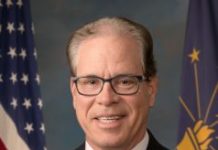One More Day In America
- By John Krull, TheStatehouseFile.com
- While our nation still reels from the slaughter of schoolchildren and teachers in Uvalde, Texas, a gunman in Tulsa, Oklahoma, murdered four more people.
Four more people with hopes, dreams, worries, and people they loved and who loved them. Four more people who deserved to go on living.
The gunman came to the medical building to unleash hell because he wanted to kill the doctor who had performed back surgery on him and anyone who got in his way. The shooter was upset that his back pain had not disappeared and had decided the doctor deserved to die because of that discomfort.
The gunman bought the semiautomatic rifle he used to kill his victims just a couple of hours before he began his slaughter. It was a legal purchase in Oklahoma.
We might as well have created a drive-through option for committing mass murder.
Just another day in the gun-happy U.S.A.
It’s hard to know exactly how many firearms-related massacres have occurred in America.
That’s because there are varying definitions of what constitutes a mass shooting.
Some researchers consider a mass shooting to be an incident in which three or more people are killed or wounded. Others say at least four people must be killed or wounded. Still others say at least four people must die to be included in the counting.
That’s why the tallies vary.
By the least restrictive accounting system—the one that requires only three people to be shot to qualify—we Americans have experienced nearly 300 mass shootings this year.
And the year is not even half over.
By the most restrictive accounting, we have seen more than 200.
Either way, it’s a lot.
A lot of suffering.
A lot of grief.
A lot of death.
The mass shooting numbers don’t include the daily, sadly routine individual gun-related deaths in the United States. According to the Gun Violence Archive, as of June 3, 18,320 Americans had lost their lives in firearms-related incidents.
To put that in perspective, as of June 1, just under 5,000 Ukrainian civilians had been killed by the Russians in their bloody war of aggression.
Think about that for a moment.
More people have died by guns in America’s supposedly peaceful streets, schools, grocery stores, hospitals and other places than in a beleaguered nation wracked by one of the deadliest wars in recent history.
Just another day in the gun-happy U.S.A.
Perhaps the great tragedy of all this is that this is not the America that most Americans want. Surveys consistently show that anywhere from 70% to 90% of Americans want laws making it harder for people to buy weapons on impulse. They want to have a better idea if someone in their community is assembling an arsenal. And they want to make it harder—much harder—for disturbed or angry people to get their hands on deadly weapons, which is the reason for the overwhelming support for background checks and waiting periods.
In fact, only about 10% of the public—a radicalized minority—believes America’s gun laws are too restrictive.
Yet they’re the ones calling the shots when it comes to America’s gun laws.
Literally.
The cost of continuing to give this radicalized minority its way is clear.
The rest of us must be willing to live in an America in which schoolchildren are murdered on an almost routine basis. We must accept the fact that we live in a nation in which a disturbed man angry with the doctor who tried to help him can pick up a military-style weapon on his way to an appointment to commit murder.
Is that the America we want?
On the day after the mass murder in Tulsa, another shooter opened fire, this time at a funeral in Racine, Wisconsin. Only two people were injured, so it doesn’t qualify as a mass shooting.
It was just another moment in another otherwise quiet corner of our country.
Just another day in the gun-happy U.S.A.
FOOTNOTE: John Krull is director of Franklin College’s Pulliam School of Journalism and publisher of TheStatehouseFile.com, a news website powered by Franklin College journalism students. The opinions expressed by the author do not reflect the views of Franklin College or the City-County Observer.





